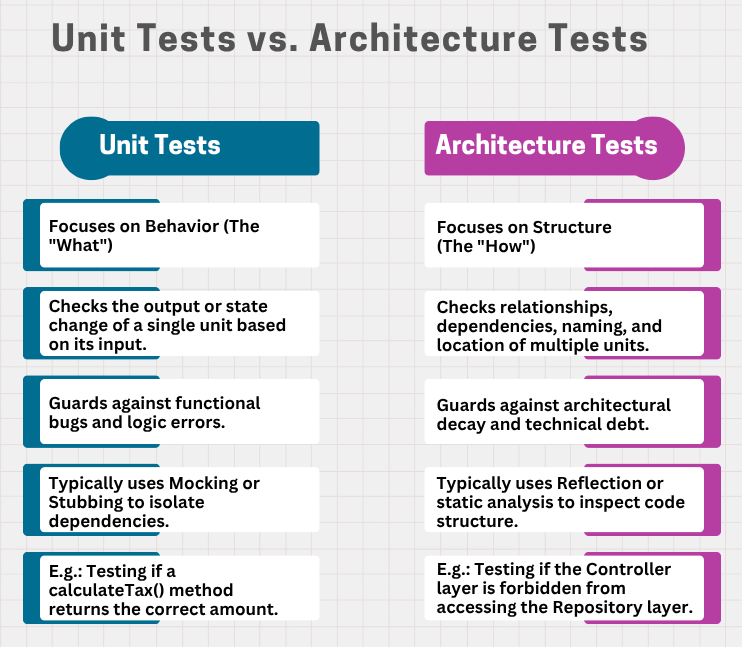What Are Architecture Tests? A Complete Guide to Software Architecture Testing
|
|
It becomes more and more challenging to maintain that original architectural vision as your codebase grows from a small, neat project to a massive multi-team application. In many cases, this decay is silent; you simply see parts of the codebase grow too big, too monolithic.
It’s actually surprisingly easy to break fundamental rules, even for seasoned developers. Perhaps the Presentation layer starts talking directly to the Data Access one. Or a newly created module introduces some unplanned dependency between two services that should’ve remained isolated. These small violations, seemingly harmless at first, add up. That’s the process of creating dangerous “shortcuts,” which quickly becomes a spiral of technical debt.
Luckily, there is an increasingly popular way of managing this: Software Architecture Testing.

| Key Takeaways: |
|---|
|

What are Architecture Tests?
Consider architecture tests as a way to ensure your design assumptions are checked automatically. This means that your codebase always complies with the structural assumptions that you intended since before code creation. These tests act as automated stockaders, ensuring that the framework does not deteriorate with time.
While conventional testing, whether unit, integration, or end-to-end, is concerned with “does this feature operate?”, architecture testing considers “Is our code well-structured?”
Hence, as you can see, the focus shifts from functional rules to structural rules.
Key Concepts in Software Architecture Testing
- Codified Policy: In the past, architectural rules lived in documents that nobody read or maintained. Architecture testing changes that by turning those rules into code. The core concept here is that the policy isn’t just documented; it’s executable. If your code deviates from the rules written in the architecture test, the build fails. The code is the policy.
- Dependency Rule Enforcement: Every modern design aims to protect its core business logic from volatile things like databases, UIs, and frameworks. Dependency enforcement is the concept of automatically ensuring that critical layers (like your Domain) are not allowed to call, or depend on, lower-level, mutable layers (like your Infrastructure). It creates a one-way street of technical control.
- Structural Reflection: Unlike functional tests that execute methods, architecture tests rely on the concept of reflection to examine the code’s structure. They load the compiled application’s modules and analyze its static properties: which package calls which, what names classes have, and where files are physically located. This structural inspection allows the test to “see” the architecture without ever running a single feature.
- Fitness Functions (The Goal): This is the high-level concept. Coined by authors like Neal Ford and Rebecca Parsons, a fitness function is an objective metric that measures how well the architecture adheres to a specific quality attribute (like security, performance, or maintainability). An architecture test, therefore, is simply a type of automated fitness function designed to ensure structural health.
- Acyclic Dependency Checks: The concept of Acyclicity is critical to maintainability. A cyclic dependency (or circular dependency) happens when Package A depends on Package B, and Package B also depends on Package A. This creates a tight coupling that makes refactoring, testing, and understanding the code nearly impossible. Architecture tests automatically verify that no such cycles exist.
- Module Boundaries: This is the practical application of dependency rules. Modern software is broken into smaller, independent modules or packages (e.g., a “Billing” module, a “User Auth” module). Architecture tests enforce explicit contracts between these modules, ensuring, for example, that the Billing module cannot directly call private functions within the User Auth module. They maintain the encapsulation necessary for microservices or modular monoliths.
Common Architectural Principles to Test
- Layering: The classic check: ensuring the Presentation layer doesn’t bypass the Business Logic layer to talk directly to the Data layer.
- Dependency Rules: Enforcing one-way streets. For instance, ensuring your Domain layer – the most important part of your application – remains pure and never depends on volatile layers like Infrastructure or UI.
- Naming Conventions: Simple yet powerful. You can enforce that all interfaces must start with ‘I’ or that all database repository classes must end with the suffix ‘Repository’. This keeps the codebase consistent and searchable.
- Security Policies: Automated checks for security-critical design decisions. This could include ensuring that all classes that handle sensitive data (like those in a security package) are marked as final (cannot be extended) or that they do not expose public setters.
- Size and Complexity Constraints: Tests that enforce maintainability by setting limits. This might involve failing the build if a class file exceeds 500 lines, or if a method’s cyclomatic complexity surpasses a certain threshold (like 15). These constraints ensure the codebase remains readable and refactorable.
Some interesting reads:
- System Design vs. Software Architecture
- How to Write Effective Test Scripts for Automation?
- How to Write Maintainable Test Scripts: Tips and Tricks
Why Software Architecture Testing is Essential for Quality and Maintainability
Here are the main reasons why you need software architecture testing.
Enforcing Design: Guaranteeing Blueprint Compliance
Despite all the theorizing during the designing sessions, there’s a high chance that your architecture blueprint won’t be followed to the T. An architecture test is an automatic and tireless design reviewer. It doesn’t care about your latest feature commit; it only wants to make sure your latest new class doesn’t violate the rule that the presentation layer doesn’t talk directly to the database. This is the way to bring the theoretical design to an actual realization level.
Reducing Technical Debt by Catching Violations Early
Technical debt – those shortcuts and small messes that pile up – often starts with one simple architectural violation. A developer makes a tiny, “harmless” direct database call from a service layer. Two months later, that violation is copied everywhere, and now fixing it is a massive, costly refactoring project.
Architecture tests prevent this accumulation. By running on every commit or pull request, they catch violations the second they happen. A failed build is a loud, impossible-to-ignore warning, ensuring you pay the small debt (refactoring one line) right now, instead of incurring massive interest later.
Improving Onboarding and Collaboration
Imagine you’re a new developer joining a massive project. Instead of spending days reading dense architectural documentation, you can run the architecture tests. When you inevitably try to call a forbidden class or bypass a required abstraction, the test immediately fails, giving you clear feedback. These tests serve as living, executable documentation. They define the boundaries of the system in code, making it instantly clear to any new team member what the rules of engagement are. This radically speeds up onboarding and ensures consistency across a large, diverse team.
Refactoring Safety: Giving Developers Confidence
Refactoring is necessary for code health, but it’s often a terrifying process, especially in a complex, coupled system. If you want to move a whole set of classes into a new package, how do you know you haven’t broken a vital dependency rule and introduced a cycle?
Architecture tests are your safety net. They allow you to make sweeping structural changes with confidence. If you refactor your Data Access layer, and the architecture tests pass, you have ironclad proof that you didn’t accidentally introduce an illegal dependency into your core Domain. They verify that the structural integrity remains intact, even when the underlying files are shuffled.

Architecture Tests in the Modern Testing Landscape
Apart from architectural tests, we have many more tests that verify the application at various levels. Take the testing pyramid, for example. Where exactly do architecture tests land in this hierarchy?
The Testing Pyramid Revisited
The testing pyramid comprises the unit tests (base layer), integration tests (middle layer), and end-to-end tests (top layer). Architecture tests don’t replace any of your existing testing levels; they strengthen the foundation.
Generally, these tests belong right alongside your Unit Tests at the broad base of the pyramid. Like unit tests, they are:
- Fast: They rely on static analysis and reflection, meaning they execute almost instantly without starting up any services or requiring a database connection.
- Cheap: They are easy to write, easy to maintain, and require minimal setup.
- Foundational: By verifying the structural integrity of your code from the ground up, they ensure the rest of your tests – the integration and E2E layers – are built on a solid, maintainable design.
How Architecture Tests Fit with Other Testing Levels
To understand their value, you must know what they don’t test and how that differentiates them from the other layers:
| Testing Level | Primary Focus (Behavioral) | Secondary Focus (Structural) |
|---|---|---|
| Unit Tests | Does this method return the correct value? | Architecture Tests check the allowed relationships between classes. |
| Integration Tests | Do Service A and Service B communicate successfully? | Architecture Tests check the design boundaries that allow (or forbid) that communication. |
| System/E2E Tests | Can the user complete the checkout process? | Architecture Tests prevent the structural debt that makes E2E tests complex and flaky. |
Read: How to Customize the Testing Pyramid: The Complete Guide

Practical Guide to Writing Good Architecture Tests (With Examples)
How do you actually turn your design rules into executable code? It starts with choosing the right tools and then writing simple, clear assertions.
Tools and Frameworks for Architecture Testing
Architecture testing is often language-specific because the tools need to inspect the compile-time structure of that particular language. Here are some frameworks that have made codified architecture testing mainstream:
- ArchUnit for Java: It allows you to write powerful, readable rules directly in plain Java. You can use its fluent API to express complex constraints like, “Classes named *Controller must not depend on classes named *Entity”. It integrates seamlessly with JUnit, meaning you can run it just like any other test.
- NetArchTest For .NET: NetArchTest offers a very similar experience to ArchUnit. It allows you to use C#’s strong typing to define architectural constraints on your assemblies, types, and dependencies. It’s perfect for ensuring your Clean Architecture or Layered Architecture rules are never violated in C# projects.
- Python/Other Languages: While some languages may not have dedicated, highly mature frameworks like ArchUnit, you still have options. For Python, developers often rely on static analysis tools like Pylint or mypy combined with custom checks to enforce structural rules. For other languages, look for custom static analysis approaches or tools that inspect the language’s build artifacts or abstract syntax tree (AST). The core principle – automated structural verification – can be implemented anywhere, even if it requires a little more custom code.
Concrete Examples of Architecture Test Cases
Example 1: Layer Dependency Assertion
This is the most common and vital test. It enforces the one-way flow of control in your layered design, protecting the core of your application.
-
The Rule: Classes in the Controller package (Presentation layer) must only access classes in the Service package (Business Logic layer). They are forbidden from directly accessing the Data Access layer.Example (ArchUnit style):
layeredArchitecture() .consideringAllDependencies() .layer("Controller").definedBy("..controller..") .layer("Service").definedBy("..service..") .layer("Persistence").definedBy("..persistence..") .whereLayer("Controller").mayNotBeAccessedByAnyLayer() .whereLayer("Service").mayOnlyBeAccessedByLayers("Controller") .whereLayer("Persistence").mayOnlyBeAccessedByLayers("Service")
Example 2: Naming Convention and Annotation Enforcement
With naming conventions and annotations, you end up maintaining hygiene in your code. However, it’s very tempting to not include these practices, and hence, architecture tests can help you with enforcing these rules.
-
The Rule: All classes annotated with @RestController must reside in a package named com.app.api.controllers.Example (ArchUnit style):
classes().that().areAssignableTo(EntityManager.class) .should().onlyHaveDependentClassesThat().areAnnotatedWith(Transactional.class)
Example 3: Forbidden Dependencies
Sometimes, you need to strictly check a specific library, utility, or class for security, performance, or migration reasons.
-
The Rule: No code should use the legacy System.out.println() utility or access the old, retired javax.swing package.Example (ArchUnit style):
classes().that().resideInAPackage("..foo..") .should().onlyHaveDependentClassesThat().resideInAnyPackage("..source.one..", "..foo..")
Best Practices for Implementing Architecture Tests
Getting started with architecture testing is simple, but making it stick requires a few best practices.
Start Small: Target High-Impact Rules First
When you first introduce architecture tests to an existing codebase, the temptation is to write every rule you can think of. Don’t. You will likely generate a massive list of violations that will overwhelm the team and delay adoption.
Instead, start with one or two high-impact rules:
- The most critical layering constraint: e.g., the Presentation layer must never access the Database layer. This protects the core structure.
- The most dangerous dependency: e.g., No code should use a known-bad or deprecated library.
Once these foundational tests are passed and the team is comfortable, you can gradually introduce more rules, such as naming conventions or more granular dependency checks.
Make Them Part of the CI/CD Pipeline
An architecture test that isn’t run automatically is just another piece of documentation that will eventually be ignored. The moment a developer introduces an architectural violation, say, by making an illegal call between layers, the Continuous Integration (CI) pipeline must catch it and reject the commit or pull request. Running these tests early, often, and automatically is the only way to guarantee that violations are fixed immediately, preventing technical debt from ever entering your main branch.
Keep Rules Readable and Explicit
The architecture test files themselves should serve as clear, executable documentation. If a developer needs to read a complex, multi-line nested statement to understand a rule, they probably won’t.
- Use Descriptive Names: Name your test methods clearly: DomainLayerShouldBeFreeOfFrameworksTest is better than Test1.
- Write Clear Intent: If your tool allows (like ArchUnit), use natural language assertions so the rule’s purpose is immediately obvious.
- Document Exceptions: If you must make an exception for a specific class, clearly document why in the test file itself.
Use Tests as Living Documentation of the Architecture
When a new developer joins your team, they usually start by asking, “How is this thing put together?” Instead of pointing them to a six-month-old diagram, point them to your architecture tests.
These tests show exactly which components are allowed to interact and which are forbidden. A passing architecture test suite confirms that the documented architecture is the actual architecture. By making your design rules explicit and executable, the tests ensure that your documentation is always up-to-date and completely accurate.
Conclusion
Architecture tests are your automated, always-on design reviews. They’re the structural safeties that functional tests can’t provide. By storing your dependency rules, naming conventions, and layer boundaries in the code, you create a system that remains maintainable, scalable, and resilient.
| Achieve More Than 90% Test Automation | |
| Step by Step Walkthroughs and Help | |
| 14 Day Free Trial, Cancel Anytime |












